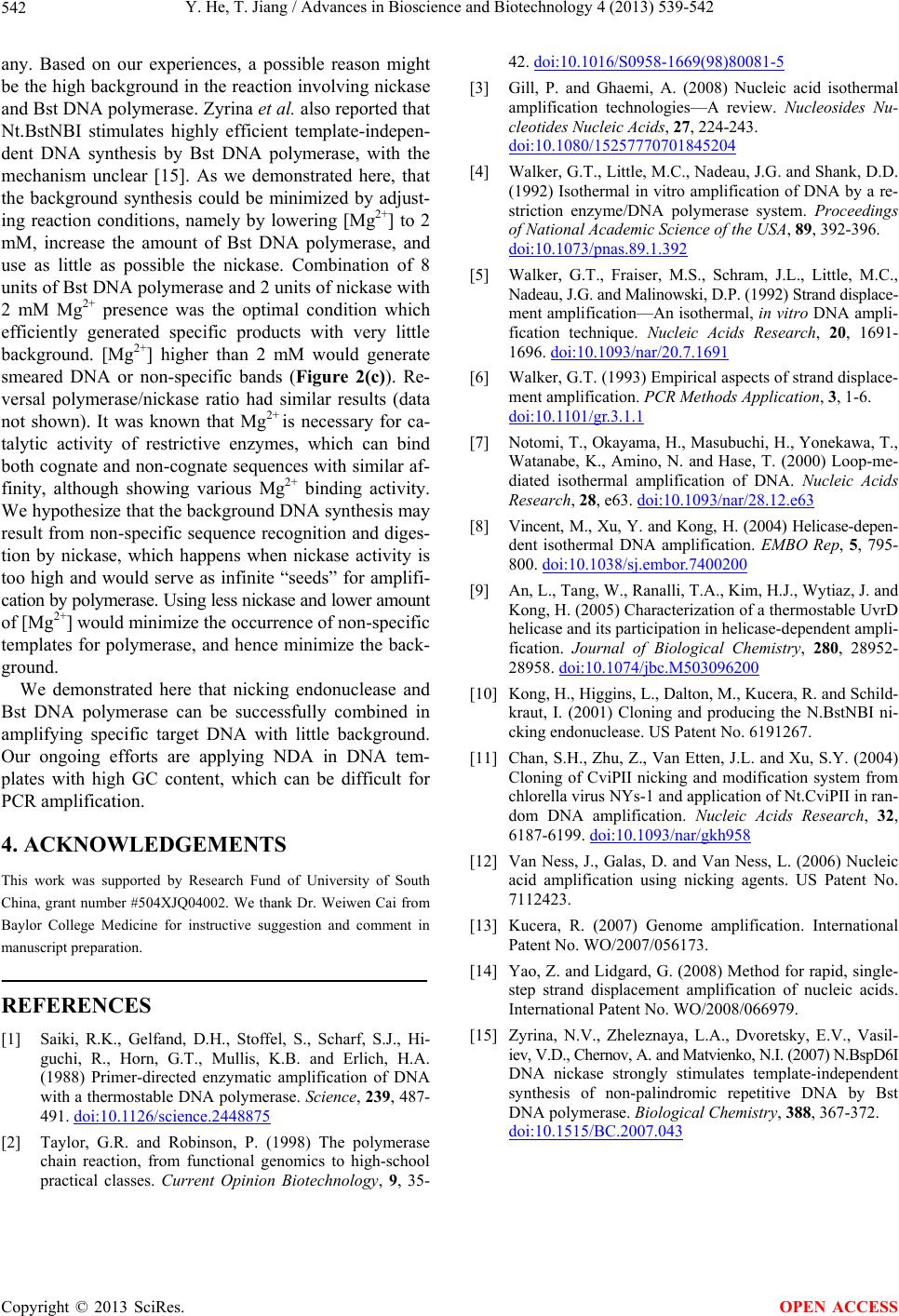
Y. He, T. Jiang / Advances in Bioscience and Biotechnology 4 (2013) 539-542
542
any. Based on our experiences, a possible reason might
be the high background in the reaction involving nickase
and Bst DNA polymerase. Zyrina et al. also reported that
Nt.BstNBI stimulates highly efficient template-indepen-
dent DNA synthesis by Bst DNA polymerase, with the
mechanism unclear [15]. As we demonstrated here, that
the background synthesis could be minimized by adjust-
ing reaction conditions, namely by lowering [Mg2+] to 2
mM, increase the amount of Bst DNA polymerase, and
use as little as possible the nickase. Combination of 8
units of Bst DNA polymerase and 2 units of nickase with
2 mM Mg2+ presence was the optimal condition which
efficiently generated specific products with very little
background. [Mg2+] higher than 2 mM would generate
smeared DNA or non-specific bands (Figure 2(c)). Re-
versal polymerase/nickase ratio had similar results (data
not shown). It was known that Mg2+ is necessary for ca-
talytic activity of restrictive enzymes, which can bind
both cognate and non-cognate sequences with similar af-
finity, although showing various Mg2+ binding activity.
We hypothesize that the background DNA synthesis may
result from non-specific sequence recognition and diges-
tion by nickase, which happens when nickase activity is
too high and would serve as infinite “seeds” for amplifi-
cation by polymerase. Using less nickase and lower amount
of [Mg2+] would minimize the occurrence of non-specific
templates for polymerase, and hence minimize the back-
ground.
We demonstrated here that nicking endonuclease and
Bst DNA polymerase can be successfully combined in
amplifying specific target DNA with little background.
Our ongoing efforts are applying NDA in DNA tem-
plates with high GC content, which can be difficult for
PCR amplification.
4. ACKNOWLEDGEMENTS
This work was supported by Research Fund of University of South
China, grant number #504XJQ04002. We thank Dr. Weiwen Cai from
Baylor College Medicine for instructive suggestion and comment in
manuscript preparation.
REFERENCES
[1] Saiki, R.K., Gelfand, D.H., Stoffel, S., Scharf, S.J., Hi-
guchi, R., Horn, G.T., Mullis, K.B. and Erlich, H.A.
(1988) Primer-directed enzymatic amplification of DNA
with a thermostable DNA polymerase. Science, 239, 487-
491. doi:10.1126/science.2448875
[2] Taylor, G.R. and Robinson, P. (1998) The polymerase
chain reaction, from functional genomics to high-school
practical classes. Current Opinion Biotechnology, 9, 35-
42. doi:10.1016/S0958-1669(98)80081-5
[3] Gill, P. and Ghaemi, A. (2008) Nucleic acid isothermal
amplification technologies—A review. Nucleosides Nu-
cleotides Nucleic Acids, 27, 224-243.
doi:10.1080/15257770701845204
[4] Walker, G.T., Little, M.C., Nadeau, J.G. and Shank, D.D.
(1992) Isothermal in vitro amplification of DNA by a re-
striction enzyme/DNA polymerase system. Proceedings
of National Academic Science of the USA, 89, 392-396.
doi:10.1073/pnas.89.1.392
[5] Walker, G.T., Fraiser, M.S., Schram, J.L., Little, M.C.,
Nadeau, J.G. and Malinowski, D.P. (1992) Strand displace-
ment amplification—An isothermal, in vitro DNA ampli-
fication technique. Nucleic Acids Research, 20, 1691-
1696. doi:10.1093/nar/20.7.1691
[6] Walker, G.T. (1993) Empirical aspects of strand displace-
ment amplification. PCR Methods Application, 3, 1-6.
doi:10.1101/gr.3.1.1
[7] Notomi, T., Okayama, H., Masubuchi, H., Yonekawa, T.,
Watanabe, K., Amino, N. and Hase, T. (2000) Loop-me-
diated isothermal amplification of DNA. Nucleic Acids
Research, 28, e63. doi:10.1093/nar/28.12.e63
[8] Vincent, M., Xu, Y. and Kong, H. (2004) Helicase-depen-
dent isothermal DNA amplification. EMBO Rep, 5, 795-
800. doi:10.1038/sj.embor.7400200
[9] An, L., Tang, W., Ranalli, T.A., Kim, H.J., Wytiaz, J. and
Kong, H. (2005) Characterization of a thermostable UvrD
helicase and its participation in helicase-dependent ampli-
fication. Journal of Biological Chemistry, 280, 28952-
28958. doi:10.1074/jbc.M503096200
[10] Kong, H., Higgins, L., Dalton, M., Kucera, R. and Schild-
kraut, I. (2001) Cloning and producing the N.BstNBI ni-
cking endonuclease. US Patent No. 6191267.
[11] Chan, S.H., Zhu, Z., Van Etten, J.L. and Xu, S.Y. (2004)
Cloning of CviPII nicking and modification system from
chlorella virus NYs-1 and application of Nt.CviPII in ran-
dom DNA amplification. Nucleic Acids Research, 32,
6187-6199. doi:10.1093/nar/gkh958
[12] Van Ness, J., Galas, D. and Van Ness, L. (2006) Nucleic
acid amplification using nicking agents. US Patent No.
7112423.
[13] Kucera, R. (2007) Genome amplification. International
Patent No. WO/2007/056173.
[14] Yao, Z. and Lidgard, G. (2008) Method for rapid, single-
step strand displacement amplification of nucleic acids.
International Patent No. WO/2008/066979.
[15] Zyrina, N.V., Zheleznaya, L.A., Dvoretsky, E.V., Vasil-
iev, V.D., Chernov, A. and Matvienko, N.I. (2007) N.BspD6I
DNA nickase strongly stimulates template-independent
synthesis of non-palindromic repetitive DNA by Bst
DNA polymerase. Biological Chemistry, 388, 367-372.
doi:10.1515/BC.2007.043
Copyright © 2013 SciRes. OPEN ACCESS